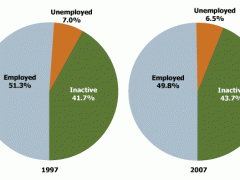Youth Unemployment and Education in Africa

In the year 2005, Africa’s youth unemployment was at 21 percent, much higher than the world average of 14.4 percent and second only to the Middle East and North Africa (MENA) region’s 25.6 percent.
Youth unemployment in Africa is a problem of alarming proportions precisely because 65 percent of the continent’s population is under the age of 24, with over 40 percent of the total population below the age of 16, and about 25 percent between the ages 15 and 24. According to the International Labour Office (ILO), youth make up approximately 36.9 percent of the total working-age population and about 60 percent of Africa’s unemployed are youth.
While Africa’s nations have seen economic growth that outstrips other continents, the high share of young people (ages 15–24) who are unemployed has the potential to undermine that growth. In addition to the economic costs of youth unemployment, there is also a social cost. As youth face long-term or cyclical unemployment, they can become disaffected and dis-invested in their own communities. This can lead to higher crime rates and greater involvement in underground economic activity, as well as social unrest.
A 2008 World Bank report entitled “Youth and Employment in Africa: The Potential, the Problem, the Promise” indicates that access to education is still a major hurdle. For example, in Kenya and Uganda, school fees were too costly for poor families, and enrollment rates were low. However, after Kenya and Uganda eliminated the school fees, completion rates for fourth and fifth graders from impoverished families increased initially.
In the case of Kenyan schools, the elimination of school fees was not enough, as detailed by a Center for Global Development working paper entitled “Why Did Abolishing Fees Not Increase Public School Enrollment in Kenya?”
Even where school enrollment increased, schools tended not to hire more teachers to accommodate their growing student body, resulting in lower qualities of education. Another factor- particularly in rural areas- is the the proximity of schools. The cost (in time or money- especially in terms of fuel use) to get to and from school is prohibitive to many parents.
As a continent, Africa has a long way to go in terms of educating, training its youth and providing opportunities to be economically active. Between heads of states who are not beholden to constitutional tenure clauses, the failure to make education generally accessible and relevant, and the burgeoning influx of migrant workers from Europe, Africa’s youth face a number of challenges. As Africa’s nations grow economically, we must be mindful of the fact that growing GDPs are not synonymous with less socio-economic inequality.
In fact, John Githongo, chief executive of Inuka Kenya Trust and chairman of the Africa Institute for Governing With Integrity and Kenya’s former secretary for governance and ethics, points out that as growth speeds up, so does inequality. In light of youth unemployment on the continent of Africa, this has huge implications on the social and political stability of Africa’s nations.
Questions:
What can be done to lower unemployment rates among Africa’s youth?
How can we better equip our youth for today’s labor market?
How can we enable African youth to become job creators without saddling them with debt?
Tags: Africa, International Labour Organization, John Githongo, Kenya, MENA, Sub-Saharan Africa, unemployment


